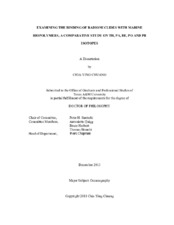| dc.description.abstract | Natural radioisotopes, Th, Pa, Pb, Po and Be, have been used as important proxies in oceanographic investigations for decades. Biopolymers, produced by both phytoplankton and bacteria, play an important role in the scavenging of these radionuclides, thus regulating the particulate organic carbon (POC)/isotope ratios in different oceanographic regions, which have been used to calculate POC flux.
To study the binding mechanisms of colloidal organic material to these radionuclides, marine colloids isolated by cross-flow ultrafiltration from seawater, together with dissolved exopolymeric substances (EPS) produced by laboratory cultured diatoms were collected. By separating, identifying and characterizing radiolabeled organic carriers, the most efficient binding of many of these nuclides likely occurs to acid polysaccharide- and Fe-related protein-containing biomolecules.
To differentiate between uptake to amorphous silica or associated biopolymers, radionuclides were incubated with diatom cultures of Phaeodactylum tricornutum. Partition coefficients (K_(d)) of radionuclides to different fractions of diatom cells, and the role of diatom related biopolymers were examined. More than 50% of selected radionuclides were bound to all-inclusive biopolymer fractions, and logK_(d) values of radioisotopes to whole diatom cells with or without silica frustules were similar, but logK_(d) values for cleaned silica frustules were orders of magnitude lower. Results from isoelectric focusing showed the most efficient binding sites occurring in acid-polysaccharides and iron-binding proteins. As revealed by 2D HSQC NMR spectra, the biopolymers in the HF insoluble fraction were mainly composed of carboxyl-rich, aliphatic-phosphoproteins.
The concentrations of potential carrier phases for radionuclides and their K_(d) values were determined for particles collected by sediment traps deployed at the Oceanic Flux Program site off Bermuda. Chemical considerations, as well as factor analysis and correlations of logK_(d) values with chemical parameters, indicate that hydroxamate-siderophores (HS) are major classes of biopolymers that have a role in binding Po and Pa. MnO_(2) and FeO_(2), whose presence is closely related to that of HS, are also involved in binding of Pa and Po. The carbonate and biogenic silica phases are identified to be important in predicting removal and fractionation of Th and Be in the ocean. | en |


